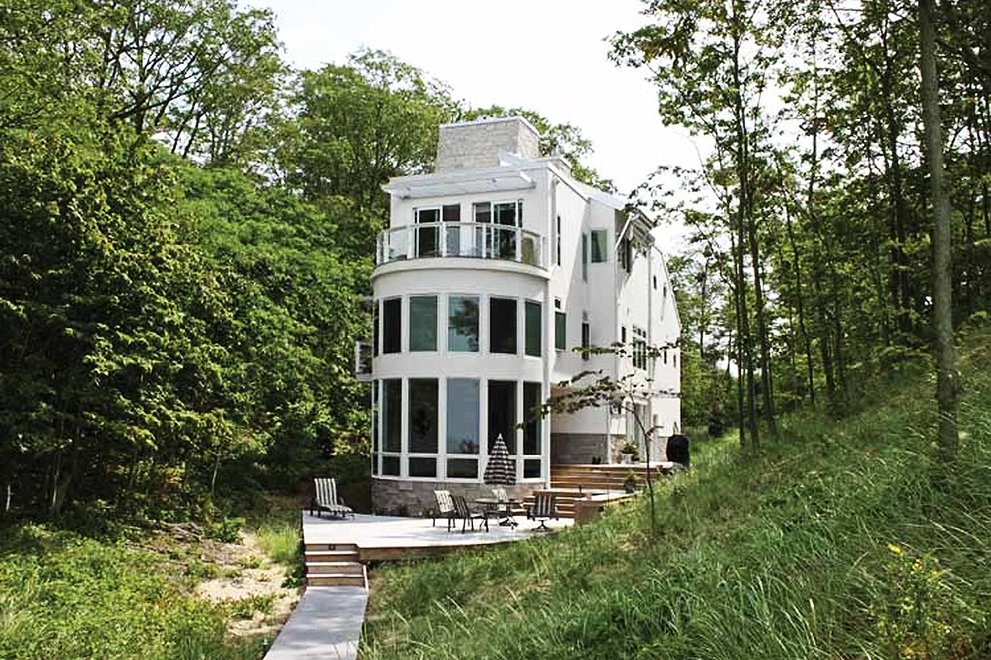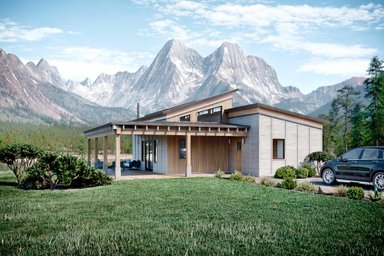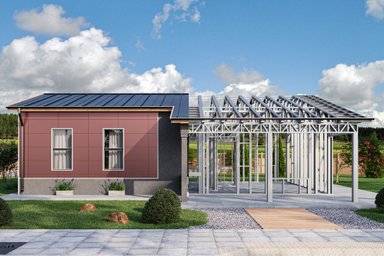Steve Linton and Leigha Dickens gave one of the most
interesting presentations at this year’s International Builders Show. The executives
at Deltec Homes, which ships modular homes throughout the country, took the
audience through the process of designing a net-zero home in different regions
of the country, highlighting cost and energy-saving tradeoffs along the way. The
audience voted over smart phones for their favorite features -- radiant
flooring, ductless air conditioners, geothermal energy.
The clear message was that the “correct” approach to energy efficiency varies dramatically by climate. Which raises the question – how would the builders achieve net-zero in their home market of Asheville, N.C.? An equally interesting question – considering that Deltec mostly builds circular homes – is whether a round building form poses any special net-zero-building challenges. A new 1,500-square foot, three-bedroom, two-bath model home by Deltec that debuted earlier this year answers these questions. Here's the layout.
Linton, president of the company, says the home’s circular shape actually saves energy, since it requires less wall area to build than a rectangular home of similar interior living space. That means it has less wall area to insulate and requires fewer windows, usually the weak link in the home-energy equation. Also, appearances can be deceiving. “Though it appears round, it actually has 17 sides,” Linton points out.
The first thing visitors notice is that the photovoltaic panels (providing 5.1kW of power) are on two stands in the yard rather than on the home’s uneven roof. It isn’t more difficult to install PV panels on the roof of a circular home, says Linton, but it may not look as orderly. “You end up with solar panels facing in many different directions,” he says. “Most commonly we like to install them on the roof of a rectangular wing that’s facing south.” What’s less apparent to visitors, even when they enter, is that this is a passive solar home. Short, two-foot roof overhangs block the sun’s rays on the hottest summer days. Otherwise, a tile floor, with
insulated concrete beneath, acts as a heat sink, storing heat from sunlight and radiating it back into rooms at night. The ancient technique evens interior temperatures during the day. The home is tightly insulated – R-30 in the sealed attic, R-24 in above-grade walls, and R-10 in the slab -- to reduce the energy loss. To provide hot water, the Deltec team elected to go with a heat pump, which can be two or three times more efficient than a conventional hot water heater. They included an energy-recovery ventilator to recover energy from exiting air to heat incoming air. “The home demonstrates what we think the best approach is in Asheville,” says Dickens.
Even so, the energy expert would take a similar approach in other regions. One tenet of net-zero home building, for instance, is to specify systems and appliances that use as little energy as possible – that way you can get away with a smaller PV system, the most costly part of the net-zero exercise. The kitchen features an induction cooktop -- more energy efficient than gas, it uses magnetism to generate electricity within stainless steel or cast iron, heating the contents in the process. A convection oven employs a fan to distribute heat evenly around the food. LED lighting is used throughout the home. And strategically placed energy sensors monitor electrical consumption.
Saving water is something you’d want to consider no matter where you live. The bathrooms feature water efficient fixtures – lav sinks with a flow rate of less than 1.5 gallon per minute, showers with a flow rate of less than 1.75 gallons per minute, and dual-flush toilets. Bath fans extract moisture from the house generated by showering and bathing, especially important in an airtight house.
The home achieved a HERS rating of 7, close enough to zero to qualify as a net-zero home. At that level, owners could manipulate their energy consumption to use no more than the house produces. Energy bills should amount to no more $329, with most of that going to one-time utility connection charges. In the second year, astute homeowners may have the local utility paying them for electricity.
Deltec sells the net-zero version of the home package for $287,000. But that doesn’t include everything you need to make it move-in ready, including a builder to assemble the modules. The company’s package – which will get you “under roof” -- includes sheathed wall panels, a roof system, exterior trim, windows (which can be installed in the wall panels), and doors (which are shipped uninstalled.) But the package doesn’t include foundation materials, plumbing, heating, electrical, and most interior items. Homeowners are on their own for paneling, sheetrock, and cabinets. Deltec will provide optional floor systems for raised foundations. It offers additional packages for decks, skylights, spiral stairs.
The Asheville model is the latest iteration of the company’s new line of Renew net-zero homes. Introduced only two years ago, the nine designs already make up 10 percent of the company’s sales, says Linton. Some of the smaller homes start at less than $100,000. “It has been the most successful launch in the company’s 50-year history,” says Linton, adding that the company will introduce new designs later in the year.
What if you wanted to build the same basic home in Minnesota? Dickens, the company’s in-house energy expert, doesn’t miss a beat to answer that question. She would stick with the passive solar design program, with both slab and perimeter insulation. She’d also continue with the induction stove, Energy Star dishwasher, refrigerator, ceiling fans, and 100 percent LED lighting. But a colder climate would require an insulation upgrade. Dickens would upgrade to a double-stud wall and pack it with dense cellulose insulation. She would upgrade to triple-pane windows and raise the R-value in the roof to keep heat from escaping in the winter. She’d stick with the Mitsubishi mini-split heat pump. It can be used in cold climates where normal heat pumps wouldn’t be as efficient. “In very cold climates, you might want to add a back-up, like an appropriate air-tight wood or pellet stove, or perhaps switch to a ground-source heat pump or high efficiency forced air natural gas or propane furnace.”
For a collection of unusually shaped floor plans on Houseplans.com click here.
The clear message was that the “correct” approach to energy efficiency varies dramatically by climate. Which raises the question – how would the builders achieve net-zero in their home market of Asheville, N.C.? An equally interesting question – considering that Deltec mostly builds circular homes – is whether a round building form poses any special net-zero-building challenges. A new 1,500-square foot, three-bedroom, two-bath model home by Deltec that debuted earlier this year answers these questions. Here's the layout.
Linton, president of the company, says the home’s circular shape actually saves energy, since it requires less wall area to build than a rectangular home of similar interior living space. That means it has less wall area to insulate and requires fewer windows, usually the weak link in the home-energy equation. Also, appearances can be deceiving. “Though it appears round, it actually has 17 sides,” Linton points out.
The first thing visitors notice is that the photovoltaic panels (providing 5.1kW of power) are on two stands in the yard rather than on the home’s uneven roof. It isn’t more difficult to install PV panels on the roof of a circular home, says Linton, but it may not look as orderly. “You end up with solar panels facing in many different directions,” he says. “Most commonly we like to install them on the roof of a rectangular wing that’s facing south.” What’s less apparent to visitors, even when they enter, is that this is a passive solar home. Short, two-foot roof overhangs block the sun’s rays on the hottest summer days. Otherwise, a tile floor, with
insulated concrete beneath, acts as a heat sink, storing heat from sunlight and radiating it back into rooms at night. The ancient technique evens interior temperatures during the day. The home is tightly insulated – R-30 in the sealed attic, R-24 in above-grade walls, and R-10 in the slab -- to reduce the energy loss. To provide hot water, the Deltec team elected to go with a heat pump, which can be two or three times more efficient than a conventional hot water heater. They included an energy-recovery ventilator to recover energy from exiting air to heat incoming air. “The home demonstrates what we think the best approach is in Asheville,” says Dickens.
Even so, the energy expert would take a similar approach in other regions. One tenet of net-zero home building, for instance, is to specify systems and appliances that use as little energy as possible – that way you can get away with a smaller PV system, the most costly part of the net-zero exercise. The kitchen features an induction cooktop -- more energy efficient than gas, it uses magnetism to generate electricity within stainless steel or cast iron, heating the contents in the process. A convection oven employs a fan to distribute heat evenly around the food. LED lighting is used throughout the home. And strategically placed energy sensors monitor electrical consumption.
Saving water is something you’d want to consider no matter where you live. The bathrooms feature water efficient fixtures – lav sinks with a flow rate of less than 1.5 gallon per minute, showers with a flow rate of less than 1.75 gallons per minute, and dual-flush toilets. Bath fans extract moisture from the house generated by showering and bathing, especially important in an airtight house.
The home achieved a HERS rating of 7, close enough to zero to qualify as a net-zero home. At that level, owners could manipulate their energy consumption to use no more than the house produces. Energy bills should amount to no more $329, with most of that going to one-time utility connection charges. In the second year, astute homeowners may have the local utility paying them for electricity.
Deltec sells the net-zero version of the home package for $287,000. But that doesn’t include everything you need to make it move-in ready, including a builder to assemble the modules. The company’s package – which will get you “under roof” -- includes sheathed wall panels, a roof system, exterior trim, windows (which can be installed in the wall panels), and doors (which are shipped uninstalled.) But the package doesn’t include foundation materials, plumbing, heating, electrical, and most interior items. Homeowners are on their own for paneling, sheetrock, and cabinets. Deltec will provide optional floor systems for raised foundations. It offers additional packages for decks, skylights, spiral stairs.
The Asheville model is the latest iteration of the company’s new line of Renew net-zero homes. Introduced only two years ago, the nine designs already make up 10 percent of the company’s sales, says Linton. Some of the smaller homes start at less than $100,000. “It has been the most successful launch in the company’s 50-year history,” says Linton, adding that the company will introduce new designs later in the year.
What if you wanted to build the same basic home in Minnesota? Dickens, the company’s in-house energy expert, doesn’t miss a beat to answer that question. She would stick with the passive solar design program, with both slab and perimeter insulation. She’d also continue with the induction stove, Energy Star dishwasher, refrigerator, ceiling fans, and 100 percent LED lighting. But a colder climate would require an insulation upgrade. Dickens would upgrade to a double-stud wall and pack it with dense cellulose insulation. She would upgrade to triple-pane windows and raise the R-value in the roof to keep heat from escaping in the winter. She’d stick with the Mitsubishi mini-split heat pump. It can be used in cold climates where normal heat pumps wouldn’t be as efficient. “In very cold climates, you might want to add a back-up, like an appropriate air-tight wood or pellet stove, or perhaps switch to a ground-source heat pump or high efficiency forced air natural gas or propane furnace.”
For a collection of unusually shaped floor plans on Houseplans.com click here.






